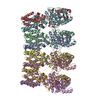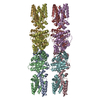+ Open data
Open data
- Basic information
Basic information
| Entry | Database: PDB / ID: 8ik0 | ||||||
|---|---|---|---|---|---|---|---|
| Title | Cryo-EM structure of Stimulator of interferon genes | ||||||
 Components Components | Stimulator of interferon genes protein,Immune protein Tsi3 | ||||||
 Keywords Keywords |  IMMUNE SYSTEM / adaptor protein IMMUNE SYSTEM / adaptor protein | ||||||
| Function / homology |  Function and homology information Function and homology informationSTING mediated induction of host immune responses / 2',3'-cyclic GMP-AMP binding /  proton channel activity / cyclic-di-GMP binding / cGAS/STING signaling pathway / reticulophagy / autophagosome membrane / proton channel activity / cyclic-di-GMP binding / cGAS/STING signaling pathway / reticulophagy / autophagosome membrane /  autophagosome assembly / positive regulation of macroautophagy / autophagosome assembly / positive regulation of macroautophagy /  autophagosome ...STING mediated induction of host immune responses / 2',3'-cyclic GMP-AMP binding / autophagosome ...STING mediated induction of host immune responses / 2',3'-cyclic GMP-AMP binding /  proton channel activity / cyclic-di-GMP binding / cGAS/STING signaling pathway / reticulophagy / autophagosome membrane / proton channel activity / cyclic-di-GMP binding / cGAS/STING signaling pathway / reticulophagy / autophagosome membrane /  autophagosome assembly / positive regulation of macroautophagy / autophagosome assembly / positive regulation of macroautophagy /  autophagosome / positive regulation of type I interferon production / activation of innate immune response / endoplasmic reticulum-Golgi intermediate compartment membrane / positive regulation of interferon-beta production / Neutrophil degranulation / protein complex oligomerization / cytoplasmic vesicle / defense response to virus / autophagosome / positive regulation of type I interferon production / activation of innate immune response / endoplasmic reticulum-Golgi intermediate compartment membrane / positive regulation of interferon-beta production / Neutrophil degranulation / protein complex oligomerization / cytoplasmic vesicle / defense response to virus /  Golgi membrane / Golgi membrane /  innate immune response / endoplasmic reticulum membrane / perinuclear region of cytoplasm / protein homodimerization activity / innate immune response / endoplasmic reticulum membrane / perinuclear region of cytoplasm / protein homodimerization activity /  metal ion binding / metal ion binding /  cytoplasm cytoplasmSimilarity search - Function | ||||||
| Biological species |   Gallus gallus (chicken) Gallus gallus (chicken)  Pseudomonas aeruginosa (bacteria) Pseudomonas aeruginosa (bacteria) | ||||||
| Method |  ELECTRON MICROSCOPY / ELECTRON MICROSCOPY /  single particle reconstruction / single particle reconstruction /  cryo EM / Resolution: 3.3 Å cryo EM / Resolution: 3.3 Å | ||||||
 Authors Authors | Lu, D.F. / Shang, G.J. | ||||||
| Funding support |  China, 1items China, 1items
| ||||||
 Citation Citation |  Journal: Mol Cell / Year: 2023 Journal: Mol Cell / Year: 2023Title: The mechanism of STING autoinhibition and activation. Authors: Sheng Liu / Bo Yang / Yingxiang Hou / Kaige Cui / Xiaozhu Yang / Xiaoxiong Li / Lianwan Chen / Shichao Liu / Zhichao Zhang / Yuanyuan Jia / Yufeng Xie / Ying Xue / Xiaomei Li / Bingxue Yan / ...Authors: Sheng Liu / Bo Yang / Yingxiang Hou / Kaige Cui / Xiaozhu Yang / Xiaoxiong Li / Lianwan Chen / Shichao Liu / Zhichao Zhang / Yuanyuan Jia / Yufeng Xie / Ying Xue / Xiaomei Li / Bingxue Yan / Changxin Wu / Wen Deng / Jianxun Qi / Defen Lu / George F Gao / Peiyi Wang / Guijun Shang /  Abstract: 2',3'-cGAMP, produced by the DNA sensor cGAS, activates stimulator of interferon genes (STING) and triggers immune response during infection. Tremendous effort has been placed on unraveling the ...2',3'-cGAMP, produced by the DNA sensor cGAS, activates stimulator of interferon genes (STING) and triggers immune response during infection. Tremendous effort has been placed on unraveling the mechanism of STING activation. However, little is known about STING inhibition. Here, we found that apo-STING exhibits a bilayer with head-to-head as well as side-by-side packing, mediated by its ligand-binding domain (LBD). This type of assembly holds two endoplasmic reticulum (ER) membranes together not only to prevent STING ER exit but also to eliminate the recruitment of TBK1, representing the autoinhibited state of STING. Additionally, we obtained the filament structure of the STING/2',3'-cGAMP complex, which adopts a bent monolayer assembly mediated by LBD and transmembrane domain (TMD). The active, curved STING polymer could deform ER membrane to support its ER exit and anterograde transportation. Our data together provide a panoramic vision regarding STING autoinhibition and activation, which adds substantially to current understanding of the cGAS-STING pathway. | ||||||
| History |
|
- Structure visualization
Structure visualization
| Structure viewer | Molecule:  Molmil Molmil Jmol/JSmol Jmol/JSmol |
|---|
- Downloads & links
Downloads & links
- Download
Download
| PDBx/mmCIF format |  8ik0.cif.gz 8ik0.cif.gz | 446.5 KB | Display |  PDBx/mmCIF format PDBx/mmCIF format |
|---|---|---|---|---|
| PDB format |  pdb8ik0.ent.gz pdb8ik0.ent.gz | 360.5 KB | Display |  PDB format PDB format |
| PDBx/mmJSON format |  8ik0.json.gz 8ik0.json.gz | Tree view |  PDBx/mmJSON format PDBx/mmJSON format | |
| Others |  Other downloads Other downloads |
-Validation report
| Arichive directory |  https://data.pdbj.org/pub/pdb/validation_reports/ik/8ik0 https://data.pdbj.org/pub/pdb/validation_reports/ik/8ik0 ftp://data.pdbj.org/pub/pdb/validation_reports/ik/8ik0 ftp://data.pdbj.org/pub/pdb/validation_reports/ik/8ik0 | HTTPS FTP |
|---|
-Related structure data
| Related structure data |  35503MC  8ik3C M: map data used to model this data C: citing same article ( |
|---|---|
| Similar structure data | Similarity search - Function & homology  F&H Search F&H Search |
- Links
Links
- Assembly
Assembly
| Deposited unit | 
|
|---|---|
| 1 |
|
- Components
Components
| #1: Protein |  / STING / Transmembrane protein 173 / Anti-toxin protein Tsi3 / STING / Transmembrane protein 173 / Anti-toxin protein Tsi3Mass: 55282.332 Da / Num. of mol.: 8 Source method: isolated from a genetically manipulated source Source: (gene. exp.)   Gallus gallus (chicken), (gene. exp.) Gallus gallus (chicken), (gene. exp.)   Pseudomonas aeruginosa (strain ATCC 15692 / DSM 22644 / CIP 104116 / JCM 14847 / LMG 12228 / 1C / PRS 101 / PAO1) (bacteria) Pseudomonas aeruginosa (strain ATCC 15692 / DSM 22644 / CIP 104116 / JCM 14847 / LMG 12228 / 1C / PRS 101 / PAO1) (bacteria)Gene: STING1, STING, TMEM173, tsi3, PA3485 / Production host:   Homo sapiens (human) / References: UniProt: E1C7U0, UniProt: Q9HYC4 Homo sapiens (human) / References: UniProt: E1C7U0, UniProt: Q9HYC4 |
|---|
-Experimental details
-Experiment
| Experiment | Method:  ELECTRON MICROSCOPY ELECTRON MICROSCOPY |
|---|---|
| EM experiment | Aggregation state: FILAMENT / 3D reconstruction method:  single particle reconstruction single particle reconstruction |
- Sample preparation
Sample preparation
| Component | Name: fiber of adaptor protein / Type: COMPLEX / Entity ID: all / Source: MULTIPLE SOURCES |
|---|---|
| Source (natural) | Organism:   Gallus gallus (chicken) Gallus gallus (chicken) |
| Source (recombinant) | Organism:   Homo sapiens (human) Homo sapiens (human) |
| Buffer solution | pH: 7.5 Details: 20mM HEPES, 150mM NaCl, 1mM TCEP, 0.03% DDM/CHS(5:1) |
| Specimen | Embedding applied: NO / Shadowing applied: NO / Staining applied : NO / Vitrification applied : NO / Vitrification applied : YES : YES |
Vitrification | Cryogen name: ETHANE |
- Electron microscopy imaging
Electron microscopy imaging
| Experimental equipment |  Model: Titan Krios / Image courtesy: FEI Company |
|---|---|
| Microscopy | Model: FEI TITAN KRIOS |
| Electron gun | Electron source : :  FIELD EMISSION GUN / Accelerating voltage: 300 kV / Illumination mode: FLOOD BEAM FIELD EMISSION GUN / Accelerating voltage: 300 kV / Illumination mode: FLOOD BEAM |
| Electron lens | Mode: BRIGHT FIELD Bright-field microscopy / Nominal defocus max: 3000 nm / Nominal defocus min: 1200 nm Bright-field microscopy / Nominal defocus max: 3000 nm / Nominal defocus min: 1200 nm |
| Image recording | Electron dose: 60 e/Å2 / Film or detector model: GATAN K3 (6k x 4k) |
- Processing
Processing
| Software | Name: PHENIX / Version: 1.19.2_4158: / Classification: refinement | ||||||||||||||||||||||||
|---|---|---|---|---|---|---|---|---|---|---|---|---|---|---|---|---|---|---|---|---|---|---|---|---|---|
CTF correction | Type: NONE | ||||||||||||||||||||||||
3D reconstruction | Resolution: 3.3 Å / Resolution method: FSC 0.143 CUT-OFF / Num. of particles: 1057869 / Symmetry type: POINT | ||||||||||||||||||||||||
| Refine LS restraints |
|
 Movie
Movie Controller
Controller




 PDBj
PDBj




